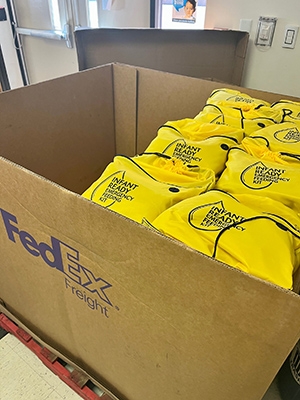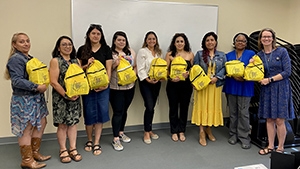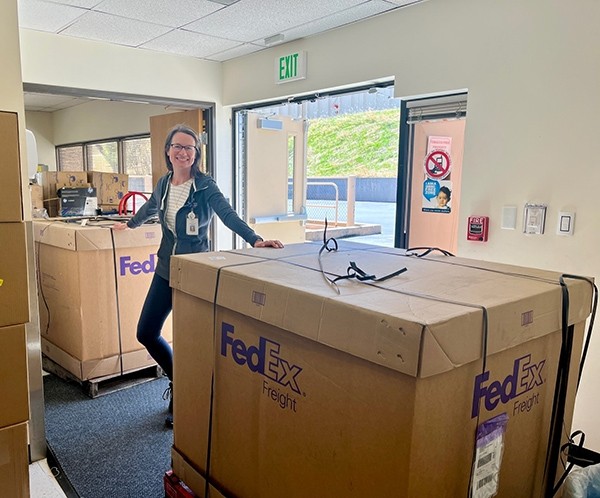Last year, with support from the Division of Reproductive Health within the Centers for Disease Control and Prevention (CDC), NACCHO provided funding to four local health departments (LHDs) to increase collaboration between maternal and child health (MCH) and emergency preparedness (EPR) programs within LHDs. By strengthening partnerships between MCH and EPR, the goal of this project was to build community resilience and improve the lives of pregnant people, birth parents, and their infants.
Over the course of a nine-month project period, NACCHO facilitated virtual action planning processes to support recipients to identify priorities for collaboration and take concrete steps to increase the prioritization women of reproductive age (WRA) within EPR programs.
To celebrate National Preparedness Month, NACCHO is highlighting the collaborations between MCH and EPR over the course of this project. We conducted an interview with awardee Allison Wilson, Strategic Initiatives Coordinator at Jefferson County Public Health in Colorado. She discussed her experiences working with NACCHO throughout the action planning process and shared successes, challenges, lessons learned, and future directions from the project year.
Q: Please provide an overview of your project and what activities you worked on throughout the project year.
A: Our goal was to move from a project we had been working on at the local level to protect safe infant feeding in emergencies and make it available statewide here in Colorado with the help of some partners. This started back in 2019 when we had identified a gap in our county and in our ten-county region and developed trainings with emergency preparedness staff. We trained 28 skilled feeding volunteers to be ready to respond and assembled 30 family kits. One of our goals from the beginning of the project was how can we make this replicable state-wide? We partnered with Rocky Mountain Medical Reserve Corps (MRC) to use our local project to teach across the state and adapt our plans to fit to their communities. The NACCHO award allowed us to focus on this project again and purchase more materials needed to create this action plan.
Q: How did your participating staff team up for this project? Were you already working with each other?
A: Prior to this NACCHO award, staff from our Maternal Child Health (MCH) team were already working with the Emergency Preparedness Director. We also were already working with the Rocky Mountain MRC prior to this project, which made things a lot easier once the project work began. The award really helped us at a key time because we had all the pieces there and it allowed us to focus on this project.
Q: What were some major successes or accomplishments you had from participating in this project?

A: I think of a few things. Some things were very concrete. We created an action plan and fulfilled it! That allowed us to reconnect with our existing training volunteers and get their input prior to rolling out the training as part of this NACCHO project. We were able to create a hybrid training that was more accessible throughout the state. Another success is that the training we developed with the MRC, so it will be a part of our community preparedness and new trainings moving forward. It will be a resource in the future to support infants and young children in emergencies. A third success is the fact that we were able to leverage the NACCHO award and other funding to increase our inventory of supplies to be ready in the case of an emergency. We only had 30 kits prepared prior to this project, and we were able to increase that to 675.
Q: Were there any challenges that you experienced during the project year? If so, what were they and how did you overcome them?
A: Capacity was a challenge early on. We wanted to make sure that at all levels, we were supporting this project because in the end, if it’s not formally in the system, it won’t always be ordered and utilized in an emergency. You can have this great local project but ensuring that the system has the capacity to support the project is always going to be a challenge. We were lucky and had awesome partners in the Rocky Mountain MRC who had the capacity to take this project statewide because we knew with just our staff at Jefferson County, we wouldn’t be able to do so.
Q: Did you develop any new skills or gain new insights around how to think about integrating MCH within EPR planning and activities?
A: We met with our emergency preparedness partners and recognized together that there is a gap in pediatric disaster planning, and we approached that gap with a concrete project/potential solution. We chose to start the relationship that way and now that it has been established, we are able to expand it to other things and identify next steps that we would work on if we had additional funding or capacity. The award helped with the realization of how to make community preparedness trainings sustainable and identifying the need to make these resources known. We were thinking about how to provide training and resources to volunteers and increase capacity by utilizing trusted relationships in the community that the volunteers have already established. So, we gained insights around new ways to integrate and expand our partnership and how to create sustainability within trainings and resources.
Q: In what ways did this project help increase MCH-EPR collaboration at your LHD?
A: In the county, we started out with a good internal relationship between the Director of Emergency Preparedness and Infectious Disease (Christine Billings) and our MCH division. They communicate well and it was very helpful to have that relationship from the start. This award helped reconnect them again after things were put on hold at the beginning of the pandemic. It helped solidify the planning and relationship and ensure that MCH and EPR were meeting regularly and communicating a lot. Then bringing in that third partner with MRC, I just can’t emphasize enough how helpful that was in terms of capacity. We were able to understand what we needed to be successful at the start, but then also where we’re going to go - a whole plan of how we can make this sustainable with them moving forward. We could better understand the role of the health department in the long term. It was helpful to see with the trainings and programs we provide how they can help support without overlapping work, so that has been strengthened. This just speaks to how public health is in so many avenues and you must make sure communication is key.
Q: What progress have you made since the project ended in May and what next steps or future directions do you envision for your project?

A: Since the project ended, we have been able to complete our first volunteer safe infant feeding training in Spanish led by our community partners from Cuenta Conmigo, and that’s for the option of being a full-skilled volunteer to respond in an emergency. That was a success because we had been working on that transcreation throughout award year but hadn’t yet given the training. We got good feedback and thought about how we can continue adapting that. We are also looking to have a small group training in-person with MRC, where we’ll be able to practice what it would look like to deploy to a site to support families around safe and young child feeding. The award allowed us to do the action planning, refine our training and materials, but then this whole year will be that full transition to MRC and understanding what role they’re playing in leading the project and the role of Jefferson County for supporting it and increasing volunteer capacity. Another big thing we’ll work on is having good networks throughout the state. We will share with the emergency preparedness partners of the health department the kits, supplies, and how to have staff train others in the community.
Q: What advice do you have for other LHDs hoping to start integrating MCH into their EPR activities?
A: I would say first, look at your relationship internally, that was really important for us. I don’t know if we would have gotten as far as we did without that as the start. It’s important that you talk together and can collaborate and agree on a first step where you’d like to focus, maybe on one thing to fill a gap to support MCH populations in emergencies. It’s really about that willingness to talk together and recognize a gap that want to focus on, then figuring out how then to work together. I do think it’s hard right now because public health is always juggling a lot of roles, but also I think through the pandemic people realized the need to adapt and talk more across divisions. So, I would say start with that internal collaboration and agreement between MCH and EPR and know that there are great examples out there. See what your community needs - the community helped us identify what a gap was in understanding EPR. See what aligns with their solutions and ideas, you need to get to people in the community that were already well involved and trusted. Another big piece of the process is knowing that it does take a lot of time. It’s slow, it takes time, but it’s doable. The power of that common goal, that community expertise and interest, will really take it far, and knowing that as a LHD we have a responsibility to advocate for systems change. I think this award is a great example of funding that allows you to be community-led and focus on something you know is needed and important, so it’s very meaningful that we were able to do a lot with that. I think it’s encouraging for other communities to know that small amounts of funding can be powerful. As much as you can, value the community’s time, and with their involvement fund them as well.
Q: Please provide any concluding thoughts about your experiences working on the project.
A: This was very useful, and the fact that it was so supportive of existing work and not having to change or start something new that matched something on paper but not on the ground was really amazing. I also appreciated the collaboration with the other three awardees. It was nice way to know that others are working on this even if it’s different strategies. It was great to have the opportunity to have thought partners and share resources. Learning from other models, write-ups, and knowing what other states are doing and continuing to connect states together is very valuable. The funding was helpful for all those things - supplies, facilitation, administration, capacity. Better connection and coordination, elevating what’s happening in the states, and connecting jurisdictions with others working on the same thing are all key for this kind of work.
To learn more about this project, view our article on Building Community Resilience Through Maternal Child Health and Emergency Preparedness and Response Collaboration.
Read our Q&A with Sue Kauppi of the Western Upper Peninsula Health Department, another awardee from this project.



